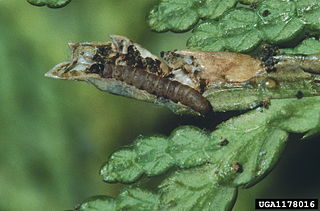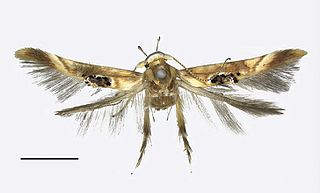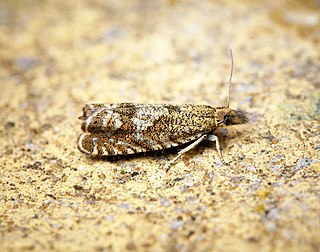Related Research Articles

Apamea crenata, known as the clouded-bordered brindle, is a moth in the family Noctuidae. It is distributed throughout the Palearctic realm. In the North it crosses the Arctic Circle, in the Mediterranean it is found only in cool locations and mountains avoiding very hot areas. In the Alps, it rises to an altitude of about 2000 metres.

Aporandria is a monotypic moth genus in the family Geometridae described by Warren in 1894. Its single species, Aporandria specularia, was first described by Achille Guenée in 1857. It is found in Sri Lanka, India, Vietnam, Thailand, the Andamans, Peninsular Malaysia, Sumatra, Borneo, the Philippines and Sulawesi.

Coleotechnites thujaella is a moth of the family Gelechiidae. It is found in the north-eastern parts of the United States, as well as Canada.

Aristotelia roseosuffusella, the pink-washed aristotelia, clover aristotelia moth or garden webworm, is a moth in the family Gelechiidae. It is found in North America, including Alabama, Georgia, Illinois, Kentucky, Maryland, Massachusetts, Michigan, New Jersey, Oklahoma, Ontario, South Carolina, Tennessee and Virginia. The species was first described by James Brackenridge Clemens in 1860.

Monochroa quinquepunctella is a moth of the family Gelechiidae. It is found in North America, where it has been recorded from Alabama, Arkansas, Illinois, Indiana, Louisiana, Maine, Massachusetts, Mississippi, New Hampshire, North Carolina, Ohio, Quebec, South Carolina and Tennessee.
Ambia cymophoralis is a moth in the family Crambidae described by George Hampson in 1917. It is found on St Aignan Island in the Louisiade Archipelago of Papua New Guinea.

Epicephala angustisaccula is a moth of the family Gracillariidae. It is found in China (Hainan).
Charistica walkeri is a moth in the family Gelechiidae. It was described by Walsingham in 1911. It is found from Panama to Colombia.
Aristotelia palamota is a moth of the family Gelechiidae. It was described by Edward Meyrick in 1926. It is found in what was then Bengal.
Aristotelia paradesma is a moth of the family Gelechiidae. It was described by Edward Meyrick in 1885. It is found in New Zealand.
Aristotelia ptilastis is a moth of the family Gelechiidae. It was described by Edward Meyrick in 1909. It is found in South Africa, where it has been recorded from the Western Cape.
Aristotelia adceanotha is a moth of the family Gelechiidae. It was described by Keifer in 1935. It is found in North America, where it has been recorded from California and Washington.
Aristotelia argentifera is a moth of the family Gelechiidae. It was described by August Busck in 1903. It is found in North America, where it has been recorded from California and western Nevada.
Aristotelia pyrodercia is a moth of the family Gelechiidae. It was described by Walsingham in 1910. It is found in Mexico (Guerrero).
Nealyda pisoniae is a moth of the family Gelechiidae. It was described by August Busck in 1900. It is found in Cuba and the United States, where it has been recorded from Florida.
Monochroa angustipennella is a moth of the family Gelechiidae. It was described by James Brackenridge Clemens in 1863. It is found in North America, where it has been recorded from California, Illinois, Maine, New Jersey, New York, Ohio, Oklahoma and Pennsylvania.
Chrysoesthia lingulacella, the silver-banded moth, is a moth of the family Gelechiidae. It was described by James Brackenridge Clemens in 1860. It is found in North America, where it has been recorded from Alberta, Arizona, California, Illinois, Indiana, Iowa, Maine, New Hampshire, Quebec and Texas.

Hieromantis arcuata is a moth of the Stathmopodidae family. It is found in China.

Hieromantis puerensis is a moth of the Stathmopodidae family. It is found in Yunnan, China.

Dichrorampha plumbagana is a moth belonging to the family Tortricidae first described by Georg Friedrich Treitschke in 1830.
References
- ↑ "Aristotelia Hübner, [1825]" at Markku Savela's Lepidoptera and Some Other Life Forms. Retrieved July 6, 2017.
- ↑ Moth Photographers Group
- ↑ Proceedings of the United States National Museum 23 (1208): 225
- ↑ Butterflyhouse.com.au